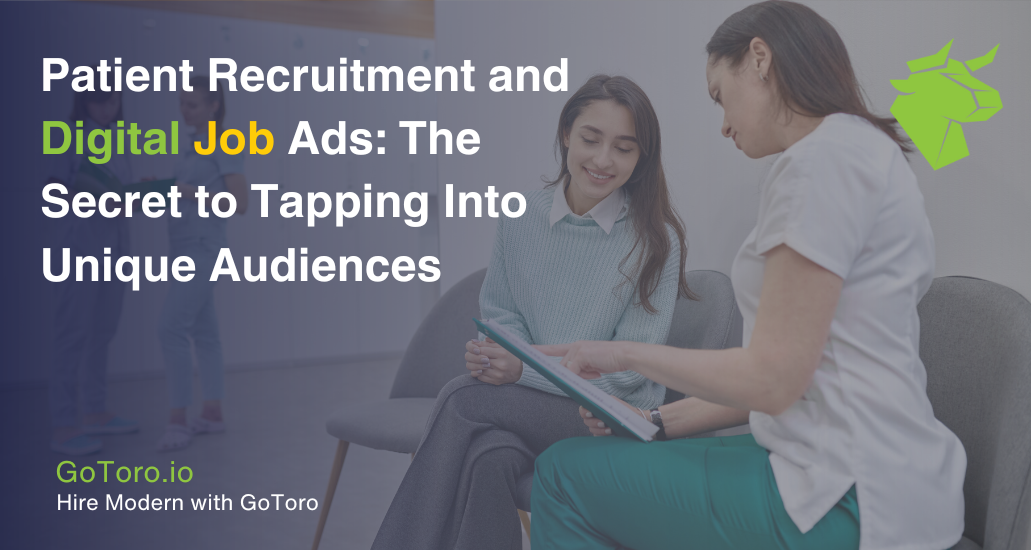Digital advertising plays a vital role in patient recruitment by offering targeted outreach to specific patient populations based on health conditions, behaviors, and demographics. Traditional recruitment methods often cast a wide net, but digital ads allow for a more precise approach, ensuring that the right message reaches the right audience.
Targeting Specific Patient Populations
One of the key advantages of digital advertising in patient recruitment is the ability to target specific patient groups. Whether you’re recruiting for a clinical trial or seeking participants for a specialized healthcare program, digital ads can be customized to reach populations based on various factors like age, geographic location, health behaviors, and even online activities. For example, a campaign targeting elderly patients with chronic conditions can focus on online forums, websites, or social media groups where this demographic is active.
Leveraging Programmatic Advertising and Social Media
Programmatic advertising is an effective tool for automating the placement of ads and ensuring that your content appears in front of the right audience at the right time. By using data to decide when and where to show ads, programmatic advertising optimizes patient recruitment efforts by reaching niche groups based on their browsing history and online behavior.
Similarly, social media platforms like Facebook and Instagram offer robust targeting features that enable recruiters to focus on users with particular health interests, behaviors, or demographics. Search engine marketing (SEM) is another method that ensures your ads appear when patients actively search for specific health-related topics, improving both visibility and engagement.
Data-Driven Recruitment Strategies for Patient Recruitment

Data-driven strategies are transforming patient recruitment by providing insights into where potential patient populations are most active online. By analyzing data from various channels—social media interactions, website traffic, and engagement metrics—companies can refine their recruitment campaigns to better target unique patient audiences.
Identifying Where Unique Audiences Are Active
Knowing where to find your target audience is crucial in patient recruitment. Analytics platforms can help companies discover which websites, forums, and social media platforms are frequented by specific patient groups. For instance, younger patients might spend more time on Instagram or YouTube, while older populations may engage more with Facebook groups or healthcare forums. This knowledge allows organizations to focus their advertising budget on the platforms where they are most likely to reach and engage their target audiences.
Refining Ad Targeting and Campaign Optimization
Data also helps in refining ad targeting. By continuously monitoring ad performance metrics such as click-through rates (CTR), engagement levels, and conversion rates, companies can tweak their ads to improve results. If an ad targeting patients with a certain health condition performs poorly, data insights can help adjust messaging, visuals, or even the platforms being used to optimize recruitment efforts.
Personalized and Targeted Messaging for Patient Recruitment
In the competitive world of patient recruitment, personalized and targeted messaging can make a significant impact on the success of recruitment campaigns. Personalized messaging not only grabs the attention of potential patients but also builds trust and fosters engagement, ultimately improving the chances of recruitment.
The Power of Storytelling in Recruitment Ads
Storytelling is a powerful tool in patient recruitment. When potential patients see themselves reflected in the narrative of an ad—whether it’s someone with a similar health condition or a shared concern—they are more likely to engage. Personalized ads tailored to the specific experiences and struggles of different patient groups build trust and create an emotional connection, encouraging participation.
For example, recruitment ads targeting elderly patients may highlight the benefits of participating in a study to improve quality of life in later years. Similarly, ads for patients with chronic conditions might focus on the long-term health benefits of joining a clinical trial, using real-world examples to resonate with those facing similar challenges.
Tailored Content for Specific Audiences
Tailored content is critical when targeting diverse patient groups. Recruitment ads for clinical trials, for instance, can be personalized for specific demographics, such as patients with diabetes or participants in pediatric research. The messaging should reflect the unique concerns, language, and needs of these patient groups, making them feel understood and valued.
For example, a recruitment campaign for a pediatric trial might focus on parental concerns, offering reassuring and informative content that emphasizes the safety and benefits of participation. On the other hand, a campaign targeting adults with a chronic illness might focus on how participation can help advance research and improve treatment options for their condition.
Leveraging Social Media for Community Engagement in Patient Recruitment
Social media platforms have become essential tools in patient recruitment, offering a unique opportunity to engage with potential participants where they spend a significant amount of time online. Platforms like Facebook, Instagram, TikTok and LinkedIn allow recruiters to reach diverse patient populations through targeted ads and organic content.
Finding and Engaging Unique Patient Audiences on Social Media
Each social media platform has its strengths when it comes to patient recruitment. Facebook groups and pages often host communities of patients discussing specific health conditions, making it an ideal platform for targeted recruitment ads. Instagram can be leveraged for visually-driven storytelling, engaging patients through compelling images and videos, while LinkedIn provides a professional space for recruiting healthcare professionals or clinical trial participants with specialized backgrounds.
The ability to use demographic, behavioral, and interest-based targeting allows healthcare organizations to tailor their patient recruitment efforts, ensuring that ads are only shown to relevant users. This approach increases the likelihood of reaching patients who are more likely to engage or participate in a trial or healthcare program.
Building Patient Communities and Leveraging Influencers
Creating online patient communities is a powerful way to foster long-term engagement. These communities provide patients with a sense of belonging and a trusted space where they can share experiences, discuss health conditions, and learn about new trials or treatments. Healthcare organizations can sponsor or actively participate in these communities to build trust and encourage participation in recruitment initiatives.
Influencers and patient advocates also play a significant role in spreading awareness. Influencers who have built credibility in specific health areas can promote clinical trials or healthcare services to their followers, driving interest and engagement in ways traditional advertising may not be able to.
The Role of Mobile Advertising in Patient Recruitment

Mobile advertising has become increasingly important in patient recruitment, as more people access healthcare information on their smartphones. With the widespread use of mobile devices, recruitment efforts must be optimized for mobile experiences to ensure that potential patients can easily engage with ads and content.
The Relevance of Mobile Advertising in Reaching Patients
Smartphones have transformed the way patients consume healthcare information. Whether researching symptoms, reading about clinical trials, or accessing healthcare apps, mobile devices have become a primary source of health-related content for many individuals. This shift means that mobile advertising must be a core component of any patient recruitment strategy.
Mobile ads can reach patients at the right moments, whether they are browsing social media, searching for health information on Google, or using healthcare apps. By placing recruitment ads in these channels, healthcare organizations can connect with potential patients where they already are.
Optimizing Patient Recruitment Campaigns for Mobile Devices
To maximize the effectiveness of mobile ads, campaigns need to be optimized for mobile devices. This includes creating mobile-friendly landing pages that load quickly, are easy to navigate, and provide essential information without overwhelming the user. Additionally, ad formats should be designed for smaller screens, using clear visuals and concise messaging that encourages immediate engagement.
Mobile-specific features, such as click-to-call or interactive forms, can further enhance patient recruitment efforts, making it easy for patients to express interest in clinical trials or services directly from their phones.
Multilingual Digital Ads for Diverse Patient Populations in Patient Recruitment
In today’s multicultural society, healthcare organizations must consider the importance of language diversity when recruiting patients. Creating multilingual digital ads allows organizations to connect with non-English-speaking populations, expanding their reach and building trust with diverse patient groups.
Reaching Diverse Patient Populations Through Multilingual Ads
Multilingual digital ads are essential for tapping into patient populations who may not speak English as their primary language. In areas with high concentrations of non-English speakers, recruitment efforts can falter if ads are not presented in the language of the target population. By offering recruitment content in multiple languages, healthcare organizations can ensure that they are inclusive and reaching all potential participants.
Whether recruiting for clinical trials or healthcare services, ads translated into languages like Spanish, Mandarin, or Arabic can dramatically increase engagement and response rates from non-English-speaking communities. This strategy ensures that patients feel more comfortable and understood, which is crucial for building trust.
The Importance of Language in Building Trust
Language plays a significant role in patient engagement and trust. Patients are more likely to engage with ads that are presented in their native language, as this demonstrates that the organization understands their needs and values their participation. Multilingual ads also help prevent miscommunication and ensure that important details about trials or healthcare services are conveyed accurately.
For healthcare organizations looking to broaden their patient recruitment efforts, investing in professional translation services and culturally relevant content is key to effectively engaging diverse populations.
Cross-Channel Integration: Combining Digital Ads with Traditional Patient Recruitment Methods

While digital advertising offers immense benefits in patient recruitment, it can be even more powerful when combined with traditional recruitment methods like in-person outreach or print advertising. This cross-channel approach creates a comprehensive strategy that increases the reach and effectiveness of recruitment efforts.
The Benefits of Combining Digital and Traditional Recruitment
Traditional patient recruitment methods, such as flyers in medical offices or in-person outreach at community events, are still effective in many contexts, particularly for populations that may not be as active online. However, by integrating these efforts with digital advertising, healthcare organizations can create a more holistic approach.
For example, digital ads can be used to raise awareness and build interest in clinical trials, while in-person outreach can provide detailed information and answer questions. This combined approach not only increases visibility but also builds trust by providing multiple touchpoints for patient engagement.
Building Trust Through a Comprehensive Recruitment Strategy
Patients are more likely to engage with recruitment campaigns when they encounter consistent messaging across multiple channels. A patient might first see a digital ad on Facebook, then receive a pamphlet at their doctor’s office, reinforcing the message and building credibility. This cross-channel strategy allows organizations to cast a wider net, ensuring that no potential participants are overlooked.
By integrating both digital and traditional methods, healthcare organizations can create a patient recruitment strategy that is both broad-reaching and highly personalized, increasing the chances of successfully engaging unique patient populations.
Regulatory Considerations in Patient Recruitment Advertising
When conducting patient recruitment, it’s essential to ensure that all advertising efforts comply with strict healthcare regulations. Adhering to laws such as the Health Insurance Portability and Accountability Act (HIPAA) is critical in protecting patient information and maintaining trust.
The Importance of HIPAA Compliance in Patient Recruitment
HIPAA is one of the most important regulations governing the protection of patient data in the U.S. During patient recruitment, advertisers must be mindful of how they collect, store, and use personal health information (PHI). This means ensuring that any data collected through digital job ads is kept secure and that patient privacy is maintained.
Non-compliance with HIPAA can result in severe penalties, so it’s vital for companies to establish safeguards that protect patient data throughout the recruitment process. This includes encrypting data, using secure platforms, and obtaining necessary patient consents before collecting any personal information.
Addressing Privacy Concerns and Ensuring Ethical Compliance
In addition to HIPAA, patient recruitment campaigns must also adhere to broader privacy regulations, such as the General Data Protection Regulation (GDPR) for European patients. Ensuring that recruitment campaigns are both ethical and compliant with these laws will help avoid legal risks and build trust with potential patients.
Recruitment efforts should prioritize transparency by clearly explaining how patient data will be used and stored. Being upfront about data usage and offering opt-in features can help patients feel more secure when considering participation in a trial or healthcare service.
Ethical Considerations Beyond Regulations in Patient Recruitment Advertising
While adhering to regulations like HIPAA is crucial, patient recruitment also requires a broader focus on ethical practices to ensure that campaigns are not only legal but also morally sound.
Avoiding Manipulation, Misinformation, and Fear-Based Messaging
Ethical advertising goes beyond compliance with the law; it involves delivering honest and clear messages to potential patients. Avoiding manipulative tactics, misinformation, or fear-based messaging is essential to maintaining trust and credibility. Patient recruitment ads should always present accurate information about clinical trials or healthcare services, without exaggerating benefits or minimizing risks.
For example, ads targeting vulnerable populations, such as patients with chronic conditions, should provide balanced and factual content. Emotional appeals should be carefully crafted to avoid exploitation while still resonating with the patient’s needs.
Ensuring Transparency and Ethical Standards in Patient Recruitment
Transparency is a cornerstone of ethical advertising. Clearly outlining the purpose of the clinical trial or healthcare program, along with any risks involved, helps build trust with potential participants. Patients should be fully informed before making decisions, and recruitment campaigns should be designed to educate rather than persuade through fear or manipulation.
Healthcare organizations should also consider the ethical implications of targeting specific populations and ensure that recruitment campaigns promote inclusivity and fairness.
Patient Journey Mapping for Better Ad Targeting in Patient Recruitment

Understanding the patient journey is crucial for creating effective recruitment ads that resonate at different stages of the decision-making process. By mapping out a patient’s journey—from researching symptoms to considering participation in a clinical trial—companies can tailor their recruitment ads to meet patients’ specific needs at each stage.
Tailoring Ads to Different Stages of the Patient Journey
Patients move through several stages when deciding whether to participate in a trial or healthcare service. These stages often include:
- Patients become aware of their health condition and start researching treatment options or clinical trials.
- Patients weigh the pros and cons of participating in a trial, often seeking reassurance about safety, benefits, and risks.
- Patients make the final decision to enroll in the trial or program.
By creating ads that cater to each stage, healthcare organizations can provide relevant information when it matters most. For example, during the awareness stage, ads may focus on raising awareness about the availability of a new clinical trial, while ads during the decision stage may highlight the benefits of participation and address common patient concerns.
Using Patient Journey Mapping for Better Targeting
Patient journey mapping helps healthcare organizations better understand patient behavior, enabling more precise ad targeting. By knowing what information patients need at each stage, companies can create content that resonates and encourages action. This approach ensures that recruitment ads are not only engaging but also highly relevant, increasing the likelihood of successful patient recruitment.
Building Long-Term Relationships with Patients Through Digital Ads
Digital advertising isn’t just about immediate patient recruitment; it can also foster long-term relationships with potential patients. Follow-up campaigns are essential for nurturing patients who showed interest but didn’t initially enroll. By maintaining communication through retargeting ads or email campaigns, healthcare organizations can keep potential participants engaged for future opportunities. These ongoing efforts help build trust and increase the likelihood of enrollment in later phases of trials or healthcare programs.
Accessibility in Digital Ads: Reaching Patients with Disabilities
Ensuring that digital ads are accessible to patients with disabilities is critical for inclusive patient recruitment. Simple adjustments, such as adding alt-text to images, using captioned videos, and designing mobile-friendly content that meets accessibility standards, make digital ads more inclusive. By adhering to these practices, healthcare organizations can reach a broader audience and ensure that no potential patients are excluded due to accessibility barriers.
Future Trends in Patient Recruitment and Digital Advertising
The future of patient recruitment lies in advanced technologies like artificial intelligence (AI) and machine learning. These tools allow for more precise targeting by predicting patient behavior and preferences. Additionally, more advanced targeting features on social media platforms and search engines will enhance the effectiveness of recruitment ads. Healthcare organizations that adopt these innovations early will be better positioned to stay ahead of the competition and meet evolving patient needs.
In conclusion, leveraging digital advertising strategies for patient recruitment can help healthcare organizations reach unique audiences, build long-term relationships, and optimize recruitment efforts through data-driven methods. Ready to take your patient recruitment to the next level? Request a demo from GoToro today and discover how our innovative solutions can enhance your recruitment campaigns.


